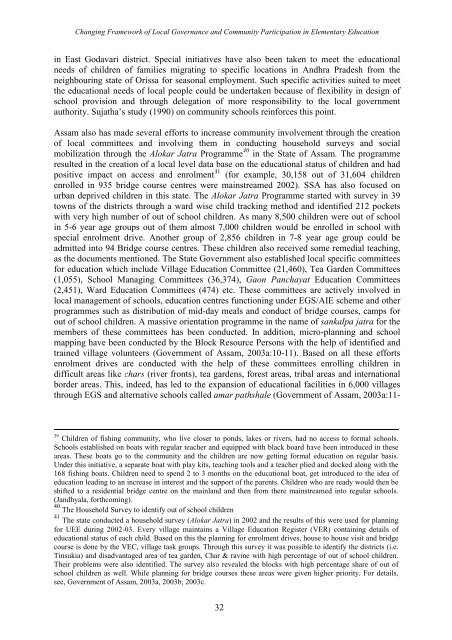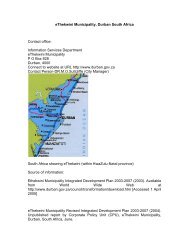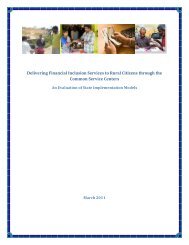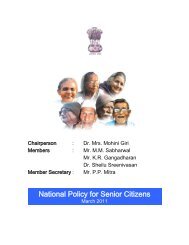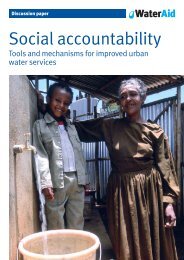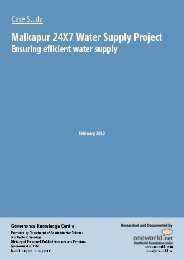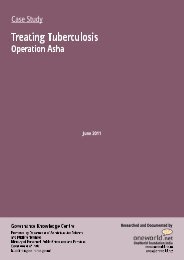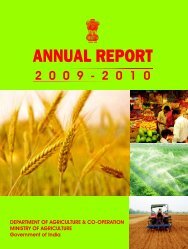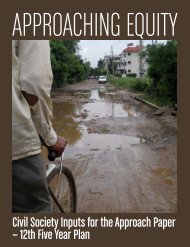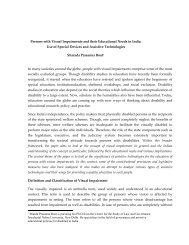Changing Framework of Local Governance and - Create
Changing Framework of Local Governance and - Create
Changing Framework of Local Governance and - Create
Create successful ePaper yourself
Turn your PDF publications into a flip-book with our unique Google optimized e-Paper software.
<strong>Changing</strong> <strong>Framework</strong> <strong>of</strong> <strong>Local</strong> <strong>Governance</strong> <strong>and</strong> Community Participation in Elementary Educationin East Godavari district. Special initiatives have also been taken to meet the educationalneeds <strong>of</strong> children <strong>of</strong> families migrating to specific locations in Andhra Pradesh from theneighbouring state <strong>of</strong> Orissa for seasonal employment. Such specific activities suited to meetthe educational needs <strong>of</strong> local people could be undertaken because <strong>of</strong> flexibility in design <strong>of</strong>school provision <strong>and</strong> through delegation <strong>of</strong> more responsibility to the local governmentauthority. Sujatha’s study (1990) on community schools reinforces this point.Assam also has made several efforts to increase community involvement through the creation<strong>of</strong> local committees <strong>and</strong> involving them in conducting household surveys <strong>and</strong> socialmobilization through the Alokar Jatra Programme 40 in the State <strong>of</strong> Assam. The programmeresulted in the creation <strong>of</strong> a local level data base on the educational status <strong>of</strong> children <strong>and</strong> hadpositive impact on access <strong>and</strong> enrolment 41 (for example, 30,158 out <strong>of</strong> 31,604 childrenenrolled in 935 bridge course centres were mainstreamed 2002). SSA has also focused onurban deprived children in this state. The Alokar Jatra Programme started with survey in 39towns <strong>of</strong> the districts through a ward wise child tracking method <strong>and</strong> identified 212 pocketswith very high number <strong>of</strong> out <strong>of</strong> school children. As many 8,500 children were out <strong>of</strong> schoolin 5-6 year age groups out <strong>of</strong> them almost 7,000 children would be enrolled in school withspecial enrolment drive. Another group <strong>of</strong> 2,856 children in 7-8 year age group could beadmitted into 94 Bridge course centres. These children also received some remedial teaching,as the documents mentioned. The State Government also established local specific committeesfor education which include Village Education Committee (21,460), Tea Garden Committees(1,055), School Managing Committees (36,374), Gaon Panchayat Education Committees(2,451), Ward Education Committees (474) etc. These committees are actively involved inlocal management <strong>of</strong> schools, education centres functioning under EGS/AIE scheme <strong>and</strong> otherprogrammes such as distribution <strong>of</strong> mid-day meals <strong>and</strong> conduct <strong>of</strong> bridge courses, camps forout <strong>of</strong> school children. A massive orientation programme in the name <strong>of</strong> sankalpa jatra for themembers <strong>of</strong> these committees has been conducted. In addition, micro-planning <strong>and</strong> schoolmapping have been conducted by the Block Resource Persons with the help <strong>of</strong> identified <strong>and</strong>trained village volunteers (Government <strong>of</strong> Assam, 2003a:10-11). Based on all these effortsenrolment drives are conducted with the help <strong>of</strong> these committees enrolling children indifficult areas like chars (river fronts), tea gardens, forest areas, tribal areas <strong>and</strong> internationalborder areas. This, indeed, has led to the expansion <strong>of</strong> educational facilities in 6,000 villagesthrough EGS <strong>and</strong> alternative schools called amar pathshale (Government <strong>of</strong> Assam, 2003a:11-39 Children <strong>of</strong> fishing community, who live closer to ponds, lakes or rivers, had no access to formal schools.Schools established on boats with regular teacher <strong>and</strong> equipped with black board have been introduced in theseareas. These boats go to the community <strong>and</strong> the children are now getting formal education on regular basis.Under this initiative, a separate boat with play kits, teaching tools <strong>and</strong> a teacher plied <strong>and</strong> docked along with the168 fishing boats. Children need to spend 2 to 3 months on the educational boat, get introduced to the idea <strong>of</strong>education leading to an increase in interest <strong>and</strong> the support <strong>of</strong> the parents. Children who are ready would then beshifted to a residential bridge centre on the mainl<strong>and</strong> <strong>and</strong> then from there mainstreamed into regular schools.(J<strong>and</strong>hyala, forthcoming).40 The Household Survey to identify out <strong>of</strong> school children41 The state conducted a household survey (Alokar Jatra) in 2002 <strong>and</strong> the results <strong>of</strong> this were used for planningfor UEE during 2002-03. Every village maintains a Village Education Register (VER) containing details <strong>of</strong>educational status <strong>of</strong> each child. Based on this the planning for enrolment drives, house to house visit <strong>and</strong> bridgecourse is done by the VEC, village task groups. Through this survey it was possible to identify the districts (i.e.Tinsukia) <strong>and</strong> disadvantaged area <strong>of</strong> tea garden, Char & ravine with high percentage <strong>of</strong> out <strong>of</strong> school children.Their problems were also identified. The survey also revealed the blocks with high percentage share <strong>of</strong> out <strong>of</strong>school children as well. While planning for bridge courses these areas were given higher priority. For details,see, Government <strong>of</strong> Assam, 2003a, 2003b; 2003c.32


